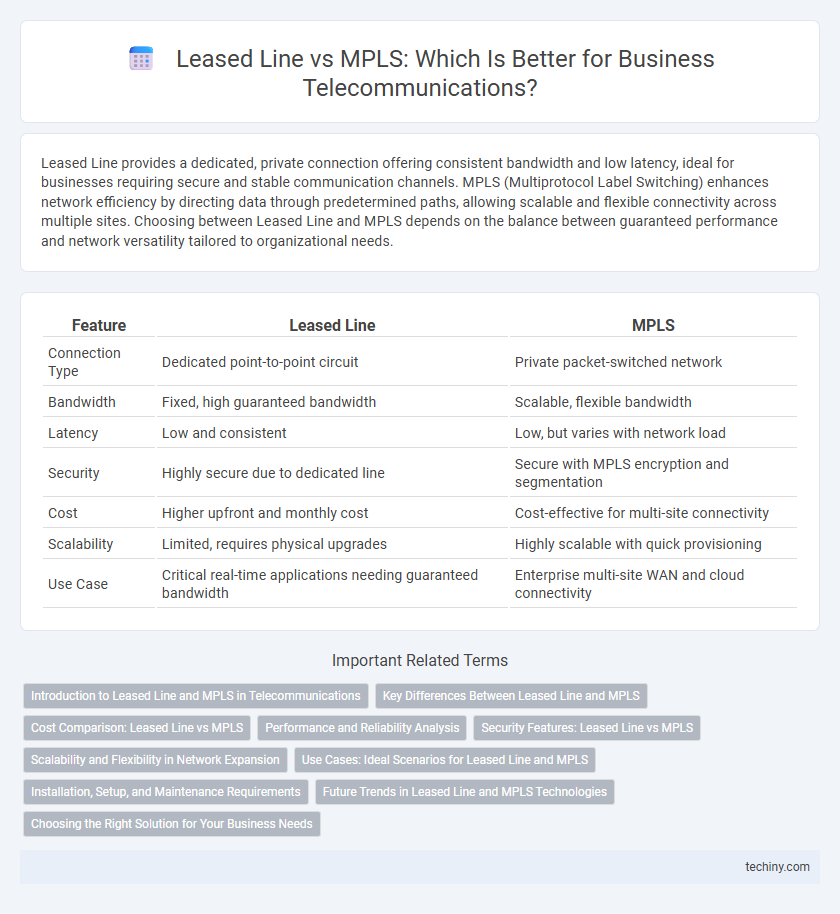Leased Line provides a dedicated, private connection offering consistent bandwidth and low latency, ideal for businesses requiring secure and stable communication channels. MPLS (Multiprotocol Label Switching) enhances network efficiency by directing data through predetermined paths, allowing scalable and flexible connectivity across multiple sites. Choosing between Leased Line and MPLS depends on the balance between guaranteed performance and network versatility tailored to organizational needs.
Table of Comparison
| Feature | Leased Line | MPLS |
|---|---|---|
| Connection Type | Dedicated point-to-point circuit | Private packet-switched network |
| Bandwidth | Fixed, high guaranteed bandwidth | Scalable, flexible bandwidth |
| Latency | Low and consistent | Low, but varies with network load |
| Security | Highly secure due to dedicated line | Secure with MPLS encryption and segmentation |
| Cost | Higher upfront and monthly cost | Cost-effective for multi-site connectivity |
| Scalability | Limited, requires physical upgrades | Highly scalable with quick provisioning |
| Use Case | Critical real-time applications needing guaranteed bandwidth | Enterprise multi-site WAN and cloud connectivity |
Introduction to Leased Line and MPLS in Telecommunications
Leased lines provide a dedicated, fixed-bandwidth connection between two sites, ensuring consistent and secure data transmission with low latency in telecommunications networks. Multiprotocol Label Switching (MPLS) optimizes data flow by using label-switching paths, enhancing scalability and traffic management across complex carrier networks. Both technologies support business-critical applications, but leased lines deliver guaranteed bandwidth, whereas MPLS offers flexible routing and cost efficiency.
Key Differences Between Leased Line and MPLS
Leased lines provide dedicated point-to-point connectivity with fixed bandwidth, ensuring consistent performance and low latency for critical applications. MPLS (Multiprotocol Label Switching) offers a scalable, flexible networking solution that efficiently routes traffic through multiple nodes using label switching, optimizing cost and bandwidth allocation. Unlike leased lines, MPLS supports dynamic traffic management across a wide area network, enhancing redundancy and enabling quality of service (QoS) prioritization for diverse applications.
Cost Comparison: Leased Line vs MPLS
Leased lines typically involve higher fixed monthly costs due to dedicated, symmetrical bandwidth and guaranteed uptime, making them more expensive for small to medium enterprises. MPLS offers cost efficiency through shared infrastructure and scalable bandwidth, reducing capital expenditure and operational costs. Businesses prioritizing budget flexibility often choose MPLS over leased lines for multi-site connectivity without compromising on performance or security.
Performance and Reliability Analysis
Leased Lines provide dedicated, symmetric bandwidth with consistent low latency and minimal packet loss, ensuring high performance for mission-critical applications and sensitive data transmissions. MPLS (Multiprotocol Label Switching) offers scalable, flexible routing with traffic prioritization and dynamic failover, enhancing network reliability and optimizing bandwidth utilization across geographically dispersed sites. Performance analysis reveals Leased Lines excel in guaranteed speed and stability, while MPLS delivers superior network resilience and cost-effectiveness for multi-site connectivity.
Security Features: Leased Line vs MPLS
Leased lines provide dedicated, point-to-point connections offering enhanced security by isolating traffic from external networks, reducing the risk of interception or unauthorized access. MPLS (Multiprotocol Label Switching) uses label-based routing to segment and prioritize traffic, enabling secure, efficient data transfer across shared infrastructure with built-in VPN capabilities for encrypted communication. While leased lines ensure physical separation, MPLS secures data through robust encryption and traffic separation techniques, making both viable but distinct options depending on organizational security requirements.
Scalability and Flexibility in Network Expansion
Leased lines offer dedicated, fixed bandwidth that provides consistent performance but limited scalability, often requiring physical infrastructure upgrades for network expansion. MPLS networks deliver enhanced flexibility by dynamically routing traffic and supporting scalable bandwidth allocation across multiple sites without extensive hardware changes. This makes MPLS a more adaptable solution for organizations seeking efficient, scalable network expansion and improved handling of evolving data demands.
Use Cases: Ideal Scenarios for Leased Line and MPLS
Leased lines are ideal for businesses requiring dedicated, high-bandwidth connectivity with low latency, such as financial institutions handling real-time transactions and data centers needing consistent performance. MPLS is suited for organizations with multiple branch offices seeking scalable, flexible, and cost-effective private WAN connectivity, enabling prioritized traffic routing and enhanced network reliability. Enterprises demanding guaranteed uptime and secure point-to-point connections often prefer leased lines, while those prioritizing network agility and complex traffic management benefit from MPLS solutions.
Installation, Setup, and Maintenance Requirements
Leased lines require dedicated physical circuits installed between endpoints, involving longer setup times and higher installation costs due to their fixed bandwidth and point-to-point nature. MPLS uses a shared network infrastructure with virtual paths, enabling quicker setup through software-based configuration and offering greater flexibility for scaling and rerouting. Maintenance for leased lines demands physical inspections and manual repairs, whereas MPLS benefits from centralized management, allowing automated fault detection and faster issue resolution.
Future Trends in Leased Line and MPLS Technologies
Future trends in leased line and MPLS technologies include increasing adoption of software-defined networking (SDN) to enhance network flexibility and management. Leased lines are evolving with higher bandwidth capacities and integration of fiber-optic infrastructure to support growing data demands. MPLS is advancing with enhanced traffic engineering and support for 5G networks to improve connectivity and reduce latency.
Choosing the Right Solution for Your Business Needs
Leased lines provide dedicated, symmetric bandwidth with guaranteed uptime ideal for businesses requiring consistent, high-speed data transfer and secure point-to-point connectivity. MPLS offers scalable, flexible network management with traffic prioritization and cost efficiency, making it suitable for organizations with multiple locations seeking optimized cloud and VoIP services. Assessing factors like bandwidth requirements, network complexity, and budget constraints ensures selection of a solution aligned with your enterprise's operational demands.
Leased Line vs MPLS Infographic

 techiny.com
techiny.com